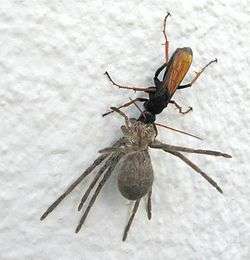Tachypompilus ignitus
| Tachypompilus ignitus | |
|---|---|
 | |
| Tachypompilus ignitus with a Palystes spider | |
| Scientific classification | |
| Kingdom: | Animalia |
| Phylum: | Arthropoda |
| Class: | Insecta |
| Order: | Hymenoptera |
| Family: | Pompilidae |
| Genus: | Tachypompilus |
| Species: | T. ignitus |
| Binomial name | |
| Tachypompilius ignitus Smith, 1781[1] | |
| Synonyms | |
| |
Tachypompilus ignitus, the rain spider wasp or red-femora spider wasp[3] is an Afrotropical species of spider wasp specialising in capturing spiders of the genus Palystes, the rain spiders.
Distribution
Southern Africa, recorded from South Africa and Zimbabwe.[1]
Description
These wasps are approximately 45mm in length.[4] They are largely black with orange antennae, orange dital parts of the legs and largely orange wing which are dark at the base and tip.[4]
Biology
Female Tachypompilus ignites largely specialise in hunting and capturing rain spiders Palystes spp. which are stung by the wasp, the sting paralyses the spider which is dragged to the wasp's nest. In the nest the wasp lays an egg on the spider and then seals the nest. When the larva hatches it consumes the spider, starting with the less vital parts to keep the spider alive for as long as possible. eating the vital organs last. Once finished consuming the prey and the larva pupates, males usually emerge before females and patrol nest sites looking for newly emerged females to mate with.[5] Baboon spiders have also been recorded as prey for this wasp.[4] Adults feed on nectar from flowers.[6]
References
- 1 2 "Tachypompilus ignitus (Smith)". Iziko Museums of South Africa. Retrieved 30 August 2016.
- ↑ "Species details : Tachypompilus ignitus (Smith, 1855)". Catalogue of Life. Retrieved 30 August 2016.
- ↑ "Observations in the Genus: Tachypompilus". The Open University. Retrieved 30 August 2016.
- 1 2 3 "Insects - Wasps". zandvleitrust. Retrieved 30 August 2016.
- ↑ Picker, Mike; Griffiths, Charles; Weaving, Alan (2004). Field Guide to Insects of South Africa (Updated ed.). Cape Town, South Africa: Struik. p. 402. ISBN 978-1-77007-061-5. OCLC 56338396.
- ↑ Vrdoljak, Sven M.; Samways, Michael J. "Agricultural mosaics maintain significant flower and visiting insect biodiversity in a global hotspot".